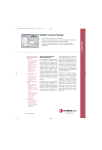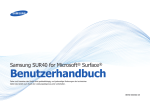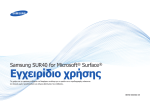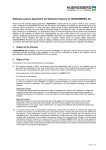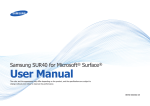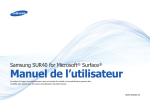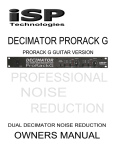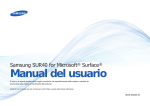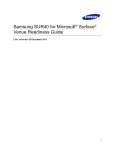Download Samsung Sur40 User's Manual
Transcript
Samsung SUR40 for Microsoft ® Surface® Enclosure Guide LAST UPDATED: 02 DECEMBER 2011 1 Copyright notice © Copyright 2011 Samsung Electronics Co., Ltd., 416, Maetan 3-Dong, Yeongtong-Gu, SuwonCity, Kyunggi-Do, the Republic of Korea. All rights reserved. Copyright in this Guide is owned by Samsung Electronics Co., Ltd. (including its affiliates, “Samsung”). You may copy this Guide only for the purpose of non-commercial use within your organization, provided that any copy of this Guide or any portion hereof must include this copyright notice. Except as expressly provided above, nothing herein shall be construed as, conferring any right or license under any copyrights, patents, trademarks or other intellectual property rights of Samsung or any third party. Without limiting the generality of the foregoing, any product, software, service or technology described or referenced in this document is the subject of intellectual property rights reserved by Samsung or its licensors and is not licensed hereunder. THIS DOCUMENTATION IS BEING PROVIDED “AS IS” AND WITHOUT WARRANTY OF ANY KIND. THE ENTIRE RISK AS TO THE COMPLETENESS, RESULTS AND PERFORMANCE OF THE INFORMATION IS ASSUMED BY THE RECIPIENT OF THIS DOCUMENTATION. ALL WARRANTIES, WHETHER EXPRESS, IMPLIED, OR STATUTORY, INCLUDING THE IMPLIED WARRANTIES OF MERCHANTABILITY, FITNESS FOR A PARTICULAR PURPOSE, TITLE AND NONINFRINGEMENT, WITH RESPECT TO THE DOCUMENTATION ARE DISCLAIMED. 2 Contents 4 Introduction 4 Scope 4 Specific criteria for enclosures 5 Mechanical and electrical requirements 6 Physical constraints 6 Unit dimensions 7 Mounting options 8 Venting locations 8 Angle orientation 8 Minimum distance to back plane 9 Dedicated I/O 9 Safety considerations 10 Sample scenario and mounting: Internal frame 16 Sample scenario and mounting: VESA mount 3 Introduction The Samsung SUR40 for Microsoft® Surface® (“SUR40”) unit enables people to communicate, collaborate and connect by easily interacting with digital content using touch and physical objects. SUR40 is designed in a revolutionary horizontal table-like form that enables people to interact with the display from any point around the device, and can also be mounted vertically or on a tilt. The device can be customized by designing an external enclosure or kiosk that cohesively integrates the unit into your environment and at the same time entices people to interact with it. The custom enclosure should be designed allowing the device to be embedded while maintaining complete access for service. If you choose to customize the exterior of the unit with a custom enclosure, this document provides important guidelines to follow during the design process. Scope This document is intended to provide guidelines that will allow you to create a customized experience for your specific venue. Specific criteria for enclosures When you design a custom enclosure, you must consider a number of specific criteria. Note: Embedding a SUR40 device into an “enclosure” must not cause the device to operate outside of its’ designed specifications. Additionally, the enclosure must not obstruct an authorized service technician from providing on-site service to that unit. Unless otherwise negotiated, doing so may void the warranty or increase service costs. Details of limitations include the following: 1. Do not modify the physical components of the unit. You should not modify device in any way including, but not limited to, the external housing or top border, power cords, or any internal components. The device is certified and compliant per international regulatory agencies. Modification may void the certification and the warranty. 2. The unit must be accessible by a technician. Access to service the device has been provided by an access panel attached to the back of the device. Please note one exception; it is permissible to obstruct the device access panel only when attached to a VESA approved mount. This would not require difficult disassembly. 3. No more than two people should be required to remove the unit from an enclosure. If more than two people are needed, the enclosure must allow easy access or removal by mechanical means, such as hydraulic cylinder jacks or removable panels. 4. The device serial number is located on the access panel. Please ensure it is accessible and readable. 5. Please read the warranty; any custom enclosures that violate the warranty may void the warranty. 4 Mechanical and electrical requirements Requirement Strength & stability Specifications Enclosure must not fall over when tilted to an angle of 10° from its normal upright position. All doors, drawers, etc. are closed during the test. (IEC 60950-1, 2001) A floor-standing unit shall not fall over when a force equal to 20 % of the weight of the unit, but not more than 250 N, is applied in any direction except upwards, at a height not exceeding 2 m from the floor. Doors, drawers, etc., which may be moved for servicing by the OPERATOR or by a SERVICE PERSON, are placed in their most unfavorable position, consistent with the installation instructions. (IEC 60950-1, 2001) A floor-standing unit shall not fall over when a constant downward force of 800 N is applied at the point of maximum moment to any horizontal surface of at least 12,5 cm by at least 20 cm, at a height up to 1 m from the floor. Doors, drawers, etc., are closed during this test. The 800 N force is applied by means of a suitable test tool having a flat surface of approximately 12,5 cm by 20 cm. The downward force is applied with the complete flat surface of the test tool in contact with the EUT; the test tool need not be in full contact with uneven surfaces (for example, corrugated or curved surfaces). (IEC 60950-1, 2001) AC power Minimal heat load Operating temperature Enclosure must be able to withstand a static load of 2000 N (equivalent to 1.5 Safety factor of unit weight plus 800 N static load). 100-240 VAC 15-20A 221 Watts/755 BTU/hour 5°C-30°C ambient 5 Physical constraints Unit dimensions 103 6 Mounting options Figure 1 – 600mm x 400mm x 8mm holes VESA Figure 2 – Internal frame mounting holes 7 Venting locations Angle orientation Device can be mounted from 0-90 degrees. Zero, being horizontal and 90 being vertically mounted such as on a VESA wall mount. Minimum distance from back plane 8 Dedicated I/O Safety considerations 1. Locate electrical power outlets and network connections in the floor adjacent to the unit. If that location is not possible, route all external cables in a way that minimizes their potential as tripping hazards. You can place a power outlet under the unit if it is elevated on a platform and provides unfettered access to the outlet so that a technician can easily unplug the power cord. 2. Do not impede access to the power cord, I/O connections, AC/Main rocker switch, and On/Standby button. All of these items must be easily and quickly accessible so you can easily turn the unit on and off and so a technician can easily service these items, if necessary. 3. Consider external vibration, air flow, temperature, power, and other operating conditions to make sure the SUR40 unit functions properly. 4. Use appropriate safety-rated (for example, UL certification) materials for your custom enclosure. 9 Sample scenario and mounting: Internal frame This scenario involves mounting a SUR40 into a table. In this instance, the unit is mounted to the internal frame (see Figure 2) to a hanger plate that has two adjustments. 10 11 12 13 14 15 Sample scenario and mounting: VESA mount 16 17

















